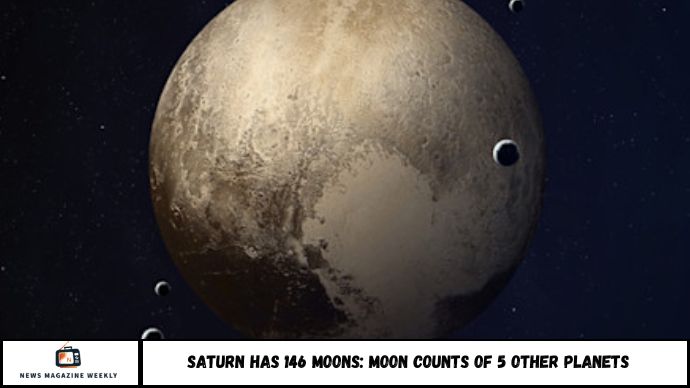Saturn leads the solar system with 146 confirmed moons, a staggering number that surpasses even Jupiter. But how many moons do the other planets have, and why do some have more than others? This article explores the moon counts of Jupiter, Uranus, Neptune, Mars, and Earth, backed by the latest astronomical data. Learn how these moons formed, what makes them unique, and how they contribute to our understanding of the solar system.
Introduction: Why Moon Counts Matter
In the vast expanse of our solar system, some planets are surrounded by dozens of moons, while others have only a few—or just one. In 2023, Saturn officially became the planet with the most confirmed moons: 146 in total. This news reignited interest in how and why planets acquire moons, and what those moons can teach us.
This article breaks down the current moon counts for five other major planets and explains why the numbers vary so widely.
Saturn: 146 Moons and the Moon King
With 146 officially confirmed moons, Saturn currently holds the record for the most moons in the solar system. These range from small moonlets just a few kilometers across to Titan, the second-largest moon in the solar system.
Why So Many Moons?
- Strong gravitational pull
- Complex ring system where moons can form and get trapped
- Ancient history of capturing and retaining small celestial bodies
Notable Moons: Titan, Enceladus, Mimas
Largest Moon: Titan (diameter: 5,150 km)
Jupiter: 95 Moons and Giant Companions
Once thought to be the moon champion, Jupiter now has 95 confirmed moons. Its four largest—Io, Europa, Ganymede, and Callisto—were discovered over 400 years ago and are still some of the most studied moons today.
Key Points:
- Ganymede is the largest moon in the solar system
- Some moons likely formed from debris or were captured asteroids
Notable Moons: Ganymede, Io, Europa
Largest Moon: Ganymede (diameter: 5,268 km)
Uranus: 28 Moons with Icy Origins
Uranus has 28 confirmed moons, many named after characters from Shakespeare and Alexander Pope. These moons are smaller than those of Jupiter and Saturn but still scientifically significant.
Characteristics:
- Mostly composed of rock and ice
- Likely formed from past collisions and subsequent accretion
Notable Moons: Titania, Oberon, Miranda
Largest Moon: Titania (diameter: 1,578 km)
Neptune: 16 Moons and a Mysterious Giant
Neptune’s 16 moons include Triton, an unusual satellite that orbits in the opposite direction of Neptune’s rotation—a sign it may have been captured from the Kuiper Belt.
Why It Matters:
- Triton is geologically active and may have a subsurface ocean
- Other moons are small and irregular, likely captured objects
Notable Moon: Triton
Largest Moon: Triton (diameter: 2,710 km)
Mars: 2 Moons and Small Companions
Mars has just 2 small moons—Phobos and Deimos. These irregularly shaped bodies are likely captured asteroids.
Quick Facts:
- Very low gravity, small size
- Phobos is gradually spiraling toward Mars and may crash into it in millions of years
Notable Moons: Phobos, Deimos
Largest Moon: Phobos (diameter: 22 km)
Earth: 1 Moon That’s Unusually Large
While Earth has only one moon, it’s quite special. The Moon is proportionally larger relative to its host planet than any other moon in the solar system (excluding Pluto’s Charon).
Key Features:
- Controls ocean tides and stabilizes Earth’s rotation
- Formed from a massive impact billions of years ago
Earth’s Moon Diameter: 3,474 km
Origin Theory: Giant-impact hypothesis
Moon Count Comparison Table
| Planet | Confirmed Moons | Largest Moon | Unique Features |
|---|---|---|---|
| Saturn | 146 | Titan | Most moons, icy surfaces, active geysers |
| Jupiter | 95 | Ganymede | Largest moon in solar system |
| Uranus | 28 | Titania | Named after literary characters |
| Neptune | 16 | Triton | Retrograde orbit, possible ocean |
| Mars | 2 | Phobos | Small, asteroid-like moons |
| Earth | 1 | The Moon | Stabilizes planet, affects tides |
FAQs
1. Which planet has the most moons?
Saturn, with 146 confirmed moons as of 2025.
2. Why do gas giants have more moons?
Gas giants have stronger gravity and more material to capture or form moons.
3. Are all moons round?
No. Many small moons are irregular in shape and resemble asteroids.
4. How many moons does Earth have?
Just one natural moon.
5. Can planets gain or lose moons over time?
Yes. Moons can be captured, collide, or drift away depending on gravitational forces.
Conclusion
Saturn’s record-breaking 146 moons highlight how dynamic our understanding of the solar system remains. From Jupiter’s nearly 100 moons to Earth’s single companion, each planet’s moon count tells a unique story of formation, capture, and cosmic history. As technology advances, these numbers will continue to evolve—expanding our knowledge of the many worlds orbiting the giants of our solar system.

